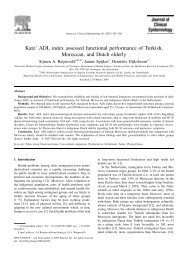Effects of Amlodipine and Lisinopril on Left Ventricular Mass ... - share
Effects of Amlodipine and Lisinopril on Left Ventricular Mass ... - share
Effects of Amlodipine and Lisinopril on Left Ventricular Mass ... - share
Create successful ePaper yourself
Turn your PDF publications into a flip-book with our unique Google optimized e-Paper software.
<str<strong>on</strong>g>Effects</str<strong>on</strong>g> <str<strong>on</strong>g>of</str<strong>on</strong>g> <str<strong>on</strong>g>Amlodipine</str<strong>on</strong>g> <str<strong>on</strong>g>and</str<strong>on</strong>g> <str<strong>on</strong>g>Lisinopril</str<strong>on</strong>g> 111Table I. Baseline characteristics <str<strong>on</strong>g>of</str<strong>on</strong>g> the 71 r<str<strong>on</strong>g>and</str<strong>on</strong>g>omized patients<str<strong>on</strong>g>Amlodipine</str<strong>on</strong>g> (n = 35) <str<strong>on</strong>g>Lisinopril</str<strong>on</strong>g> (n = 36)6 66 66 6 6 66 6Age (years) 53 10 54 11Sex (% male) 51 72Body mass index (kg/m 2 ) 27.2 4.3 27.8 3.4Office SBP/DBP (mmHg) 158 16/102 5 161 15/100 4Heart rate (bpm) 81 12 82 11SBP/DBP = systolic/diastolic blood pressure, values are mean 6 st<str<strong>on</strong>g>and</str<strong>on</strong>g>ard deviati<strong>on</strong>.<strong>Left</strong> ventricular hypertrophy was defined as: LVMI108 g/m 2 for women <str<strong>on</strong>g>and</str<strong>on</strong>g> 118 g/m 2 for men [16].Diastolic filling abnormalities were measured withpulsed Doppler echocardiography. Measurements weremade in the st<str<strong>on</strong>g>and</str<strong>on</strong>g>ard apical four-chamber view with thepatient in the left decubitus positi<strong>on</strong>. The Dopplersampling volume was placed between the tips <str<strong>on</strong>g>of</str<strong>on</strong>g> themitral valve leaflets to obtain maximal filling velocities.Three recordings were made, end-expiratory. Measurementswere performed with the Acus<strong>on</strong> calculati<strong>on</strong>s<str<strong>on</strong>g>of</str<strong>on</strong>g>tware package. Early <str<strong>on</strong>g>and</str<strong>on</strong>g> atrial peak filling velocities(E-peak <str<strong>on</strong>g>and</str<strong>on</strong>g> A-peak) were measured <str<strong>on</strong>g>and</str<strong>on</strong>g> their ratio (E/Aratio) was calculated. Time measurements <str<strong>on</strong>g>of</str<strong>on</strong>g> the earlyfilling phase were performed: early accelerati<strong>on</strong> time(EAT), early decelerati<strong>on</strong> time (EDT) <str<strong>on</strong>g>and</str<strong>on</strong>g> pressure halftime (PHT). Isovolumetric relaxati<strong>on</strong> time (IVRT) wasmeasured as time between the end <str<strong>on</strong>g>of</str<strong>on</strong>g> aortic outflow signal<str<strong>on</strong>g>and</str<strong>on</strong>g> beginning <str<strong>on</strong>g>of</str<strong>on</strong>g> mitral inflow signal in a st<str<strong>on</strong>g>and</str<strong>on</strong>g>ard fivechamberview.To study the tolerance <str<strong>on</strong>g>of</str<strong>on</strong>g> study drugs, the patients weregiven a questi<strong>on</strong>naire <str<strong>on</strong>g>and</str<strong>on</strong>g> any other untoward event thatthey reported was recorded.Statistical analysisM<strong>on</strong>itoring <str<strong>on</strong>g>and</str<strong>on</strong>g> statistical analysis (the SAS s<str<strong>on</strong>g>of</str<strong>on</strong>g>twarepackage) <str<strong>on</strong>g>of</str<strong>on</strong>g> the study was performed by an independentm<strong>on</strong>itoring agency (IMRO BV, The Netherl<str<strong>on</strong>g>and</str<strong>on</strong>g>s).Primary endpoints were LVMI <str<strong>on</strong>g>and</str<strong>on</strong>g> E/A ratio. All otherparameters were c<strong>on</strong>sidered to be sec<strong>on</strong>dary. Results areexpressed as mean 6 st<str<strong>on</strong>g>and</str<strong>on</strong>g>ard deviati<strong>on</strong> (SD). A twotailedp < 0.05 was c<strong>on</strong>sidered statistically significant. Totest for changes within <str<strong>on</strong>g>and</str<strong>on</strong>g> differences between treatmentgroups, an analysis <str<strong>on</strong>g>of</str<strong>on</strong>g> variance (ANOVA) was carried outwith the changes in endpoints as dependent variables, <str<strong>on</strong>g>and</str<strong>on</strong>g>treatment group <str<strong>on</strong>g>and</str<strong>on</strong>g> sex as fixed factors. Sex was droppedfrom the model if it was not significant <str<strong>on</strong>g>and</str<strong>on</strong>g> the statisticaltest then reduced to a t-test. Additi<strong>on</strong>ally, an analysis <str<strong>on</strong>g>of</str<strong>on</strong>g>covariance (ANCOVA) was carried out with correcti<strong>on</strong>for the baseline values <str<strong>on</strong>g>of</str<strong>on</strong>g> the primary <str<strong>on</strong>g>and</str<strong>on</strong>g> sec<strong>on</strong>daryendpoints (c<strong>on</strong>tinuous covariate). If there was a significantrelati<strong>on</strong> with the baseline value it was also testedwhether the relati<strong>on</strong> with baseline was equal (equality <str<strong>on</strong>g>of</str<strong>on</strong>g>slopes) for both treatment groups. An intenti<strong>on</strong>-to-treatanalysis (including all r<str<strong>on</strong>g>and</str<strong>on</strong>g>omized patients) was performed.Only in the case <str<strong>on</strong>g>of</str<strong>on</strong>g> a large number <str<strong>on</strong>g>of</str<strong>on</strong>g> protocolviolators (>10%), was a per protocol analysis performed(including all patients who completed the protocol).To study the relati<strong>on</strong> between changes in <str<strong>on</strong>g>of</str<strong>on</strong>g>fice <str<strong>on</strong>g>and</str<strong>on</strong>g>ambulatory blood pressure <str<strong>on</strong>g>and</str<strong>on</strong>g> changes in LVMI <str<strong>on</strong>g>and</str<strong>on</strong>g> E/Aratio, an ANCOVA was carried out. Estimates (with 95%c<strong>on</strong>fidence interval) <str<strong>on</strong>g>of</str<strong>on</strong>g> the effect <str<strong>on</strong>g>of</str<strong>on</strong>g> change in bloodpressure <strong>on</strong> the change in LVMI <str<strong>on</strong>g>and</str<strong>on</strong>g> E/A ratio werecalculated. The changes in systolic <str<strong>on</strong>g>and</str<strong>on</strong>g> diastolic values <str<strong>on</strong>g>of</str<strong>on</strong>g>the <str<strong>on</strong>g>of</str<strong>on</strong>g>fice <str<strong>on</strong>g>and</str<strong>on</strong>g> ambulatory blood pressure were includedseparately because <str<strong>on</strong>g>of</str<strong>on</strong>g> the large correlati<strong>on</strong> between theseblood pressures. The increase in fit <str<strong>on</strong>g>of</str<strong>on</strong>g> the model afterinclusi<strong>on</strong> <str<strong>on</strong>g>of</str<strong>on</strong>g> the blood pressure was used as a measure <str<strong>on</strong>g>of</str<strong>on</strong>g>correlati<strong>on</strong>. To study the relati<strong>on</strong> between change inLVMI <str<strong>on</strong>g>and</str<strong>on</strong>g> change in E/A ratio, a Pears<strong>on</strong> correlati<strong>on</strong>coefficient was calculated.RESULTSPatient’s characteristics <str<strong>on</strong>g>of</str<strong>on</strong>g> both treatment groups aregiven in Table I. There was a difference in the distributi<strong>on</strong><str<strong>on</strong>g>of</str<strong>on</strong>g> sex, however, <str<strong>on</strong>g>and</str<strong>on</strong>g> slightly higher body mass index inthe lisinopril group might be a c<strong>on</strong>sequence <str<strong>on</strong>g>of</str<strong>on</strong>g> thisfinding.In the amlodipine <str<strong>on</strong>g>and</str<strong>on</strong>g> lisinopril groups, 16 <str<strong>on</strong>g>of</str<strong>on</strong>g> 35 (46%)<str<strong>on</strong>g>and</str<strong>on</strong>g> 15 <str<strong>on</strong>g>of</str<strong>on</strong>g> 36 (42%) patients, respectively, were adjustedto the higher dose <str<strong>on</strong>g>of</str<strong>on</strong>g> 10 <str<strong>on</strong>g>and</str<strong>on</strong>g> 20 mg. After 1 year, <str<strong>on</strong>g>of</str<strong>on</strong>g>ficeblood pressures were available for 69 (97%) patients,ambulatory blood pressures for 59 (83%) patients, <str<strong>on</strong>g>and</str<strong>on</strong>g>echocardiographic measurements <str<strong>on</strong>g>of</str<strong>on</strong>g> LVMI <str<strong>on</strong>g>and</str<strong>on</strong>g> E/A ratiowere available for 57 (80%) <str<strong>on</strong>g>and</str<strong>on</strong>g> 59 (83%), respectively.Of the total <str<strong>on</strong>g>of</str<strong>on</strong>g> 59 who completed the study, 28 were in theamlodipine group (80%) <str<strong>on</strong>g>and</str<strong>on</strong>g> 31 in the lisinopril group(86%). Reas<strong>on</strong>s for not completing the study in theamlodipine group (n = 7) were: ankle oedema (1),exanthema (1), pustulae (1), withdrawal <str<strong>on</strong>g>of</str<strong>on</strong>g> informedc<strong>on</strong>sent (3) <str<strong>on</strong>g>and</str<strong>on</strong>g> no therapeutic resp<strong>on</strong>se after 12 weeks <str<strong>on</strong>g>of</str<strong>on</strong>g>treatment (1). Reas<strong>on</strong>s for not completing the study in thelisinopril group (n = 5) were: hyperkalaemia (1), dys-BLOOD PRESSURE 1998








